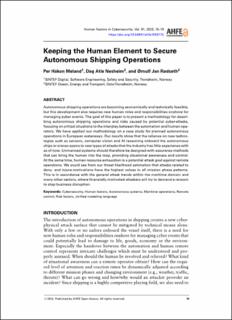| dc.contributor.author | Meland, Per Håkon | |
| dc.contributor.author | Nesheim, Dag Atle | |
| dc.contributor.author | Rødseth, Ørnulf Jan | |
| dc.date.accessioned | 2023-09-20T12:57:02Z | |
| dc.date.available | 2023-09-20T12:57:02Z | |
| dc.date.created | 2023-07-16T15:06:48Z | |
| dc.date.issued | 2023 | |
| dc.identifier.citation | Applied Human Factors and Ergonomics International (AHFE International). 2023, 91, 10-19. | en_US |
| dc.identifier.issn | 2771-0718 | |
| dc.identifier.uri | https://hdl.handle.net/11250/3090837 | |
| dc.description.abstract | Autonomous shipping operations are becoming economically and technically feasible, but this development also requires new human roles and responsibilities onshore for managing cyber events. The goal of this paper is to present a methodology for describing autonomous shipping operations and risks caused by potential cyber-attacks, focusing on critical situations to the interplay between the automation and human operators. We have applied our methodology on a case study for planned autonomous operations in European waterways. Our results show that the reliance on new technologies such as sensors, computer vision and AI reasoning onboard the autonomous ships or cranes opens to new types of attacks that the industry has little experience with as of now. Unmanned systems should therefore be designed with assurance methods that can bring the human into the loop, providing situational awareness and control. At the same time, human resource exhaustion is a potential attack goal against remote operations. We could see from our threat likelihood estimation that attacks related to deny- and injure-motivations have the highest values in all mission phase patterns. This is in accordance with the general attack trends within the maritime domain and many other sectors, where financially motivated attackers will try to demand a ransom to stop business disruption. | en_US |
| dc.language.iso | eng | en_US |
| dc.publisher | AHFE International | en_US |
| dc.title | Keeping the human element to secure autonomous shipping operations | en_US |
| dc.type | Peer reviewed | en_US |
| dc.type | Journal article | en_US |
| dc.description.version | publishedVersion | en_US |
| dc.rights.holder | © 2023. Published by AHFE Open Access. All rights reserved. | en_US |
| dc.source.pagenumber | 10-19 | en_US |
| dc.source.volume | 91 | en_US |
| dc.source.journal | Applied Human Factors and Ergonomics International (AHFE International) | en_US |
| dc.identifier.doi | 10.54941/ahfe1003715 | |
| dc.identifier.cristin | 2162443 | |
| dc.relation.project | EC/H2020/859992 | en_US |
| cristin.ispublished | true | |
| cristin.fulltext | original | |
| cristin.qualitycode | 1 | |
